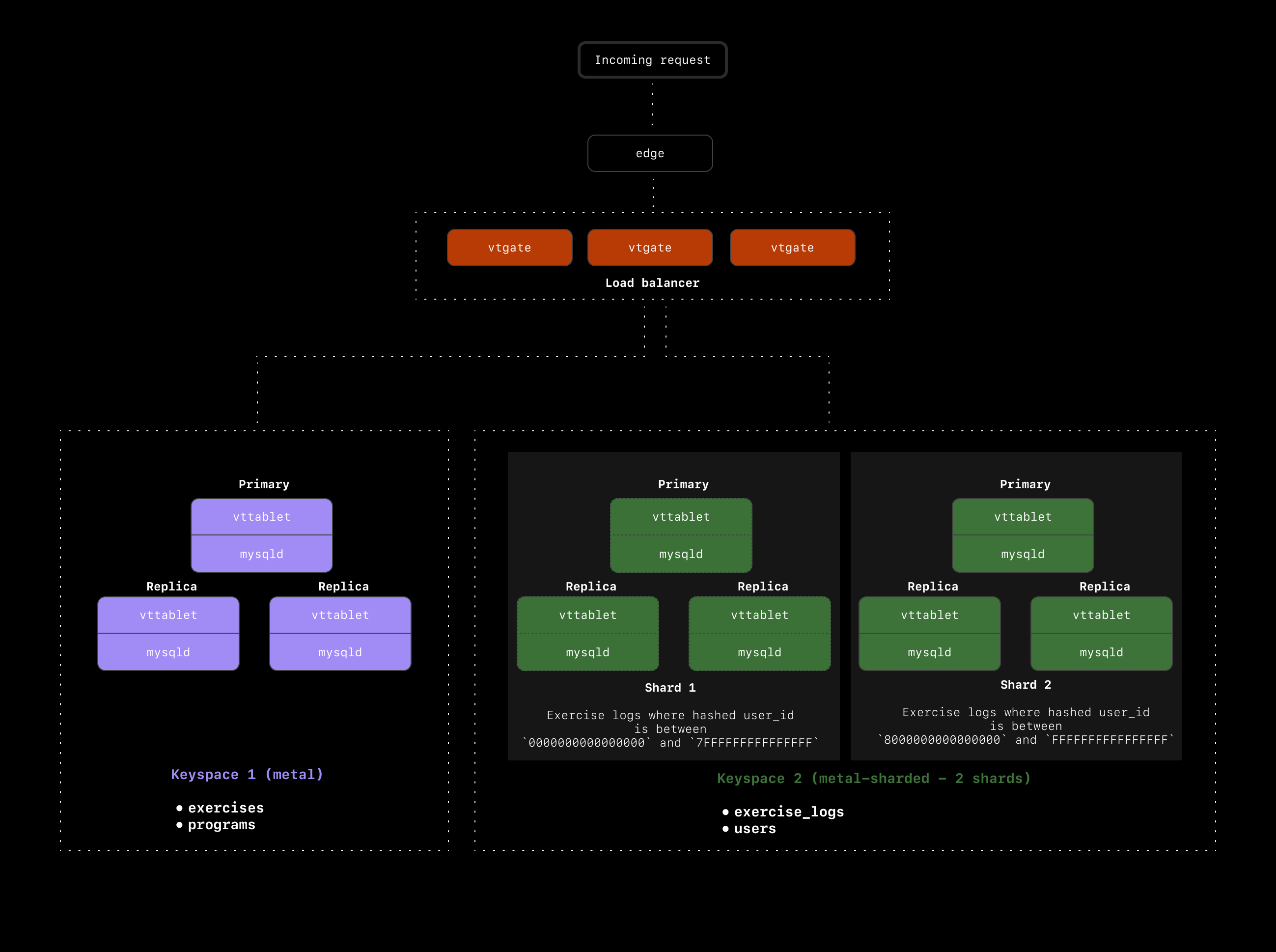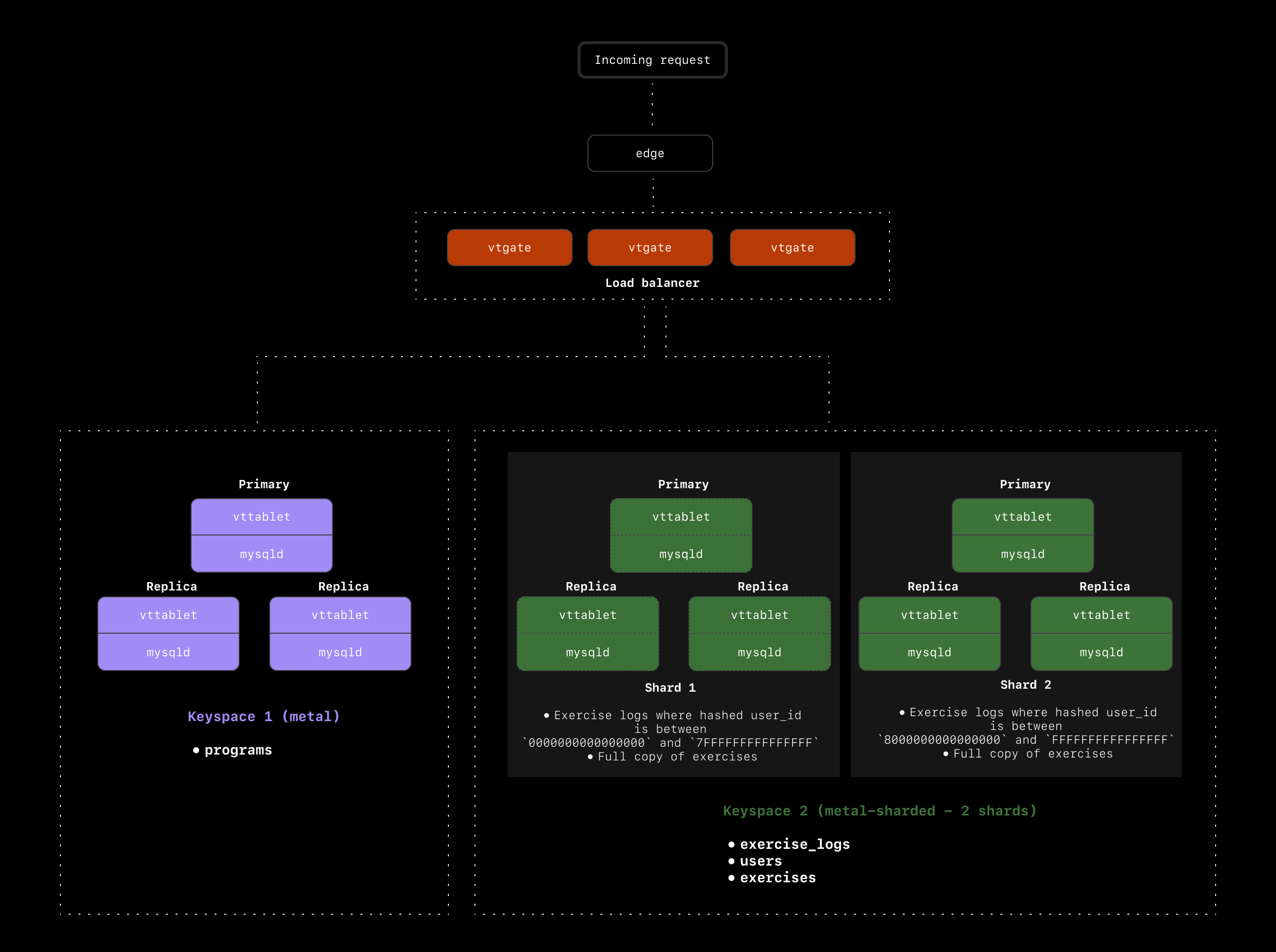JOIN with these sharded tables.
Let’s run through an example. If you prefer video content, you can watch the video on avoiding cross-shard queries here:
Sharding design example
I have an unsharded database,metal, in a single keyspace. This is the database for our gym tracker application. The database schema looks like this:
users table:
Stores the users that sign up to track their gym sessions. There are currently 200,000 users.
exercises table:
Stores all of the exercises that our users can track. This table is managed by the application owners. Users cannot add their own exercises. There are currently 200 exercises in the database.
exercise_logs table:
Stores all of the exercises that a user completes. Each exercise_log record holds all of the sets and reps you do for a single exercise at a specific weight. For example, if you do 5 sets of 3 reps of squats at a weight of 225 lbs, that is stored in a single exercise_log. If you do some warmup sets of squats at a weight of 135 lbs, that’s stored in a new exercise_log.
There are currently 65,155,000 exercise logs.
programs table:
Stores the available pre-created gym programs that a user can optionally choose. These are created by the application owners. A user cannot create their own programs. There are currently 23 programs.
Selecting candidate(s) for sharding
Based on the information above, you can see thatexercise_logs will be the first natural candidate for sharding. Each user adds several exercise_logs records every time they track a workout, so this table grows much faster than the other three tables.
We have decided to shard this table to spread the data across two shards/clusters.
Common query pattern analysis
Now that we’ve identified the table (or in some cases, tables) we want to shard, the next step is to look at our common query patterns to see if we frequently join this table to other tables. Again, here is the schema forexercise_logs:
user_id and exercise_id, it is likely that we often join this table to both users and exercises. In fact, some of our most executed queries involve joining all of these tables.
The programs table, however, is never joined with exercise_logs.
Given this information, we now must decide how to architect our sharding scheme such that we can avoid cross-shard queries as often as possible.
A closer look at our sharded table
Before we dive into the other tables, let’s look a little closer atexercise_logs. Here is an example of a common query we run to display all of the exercises a user has completed today:
exercises table and the users table on exercise_logs. For the sake of this example, let’s assume this is the most commonly executed query in our application.
Now, we know we are going to shard exercise_logs, which means we need to choose a sharding key, or primary Vindex, for this table.
Choosing a Vindex for exercise_logs
Using the primary key as the primary Vindex can sometimes be the most natural choice to shard on. Let’s start by considering id as the shard key for exercise_logs. For every row in the table, the id will be hashed with xxHash64, resulting in some hexadecimal value between 0x00000000000000000 and 0xFFFFFFFFFFFFFFFF. These values will be evenly distributed across all shards.
With this solution, if we run the above query to get all of the exercises done by a particular user in a given day, we’ll have to look across all shards because there’s no guarantee that the user’s exercise logs all ended up on the same shard.
Instead, we might want to consider sharding on exercise_logs.user_id. If we do this, every exercise_log record with the same exercise_logs.user_id will hash to the same value. So let’s say the hashed user_id of 2 comes out to 0x30F419900AA88B20. Every exercise_log for our user with id=2 will have a Vindex value of 0x30F419900AA88B20. When Vitess distributes this data across our 2 shards, the distrubtion might look like this:
Shard 1: Vindexes with values 0x0000000000000000 through 0x7FFFFFFFFFFFFFFF Shard 2: Vindexes with values 0x8000000000000000 through 0xFFFFFFFFFFFFFFFF
In this case, our user whose id hashes to 0x30F419900AA88B20 will always end up on Shard 1. This means that ultimately, with this primary Vindex, there will not be a case where a user’s exercise_logs records live on two different shards. When a request comes in to grab all of the exercise logs for a particular user on a given day, we only have to access a single shard. This is exactly what we want.
Handling frequently JOINed tables
With that out of the way, let’s again look at how we handle joining the other relevant tables.
With our current setup, we have exercises, users, and programs on the unsharded keyspace and the exercise_logs table on the sharded keyspace, as shown below:

JOINs. In this case, we’ll see a massive hit to performance, and application speed will feel slow to the end user.
Now that we have a good grasp on what we’d like to avoid, let’s come up with some solutions. The main thing we need to solve is how to avoid cross-keyspace / cross-shard joins between exercise_logs, users, and exercises.
The users table
Let’s start by looking at the users table. We already know we’re using exercise_logs.user_id as the primary Vindex, so all exercise logs for a particular user will end up on the same shard. However, when we join that user_id on the users table, we have to jump back over to the metal keyspace to access the users table.
To avoid this, we should move the users table to the metal-sharded keyspace and shard that as well. We’ll need to choose a primary Vindex for users in order to shard it. Because we sharded exercise_logs on the user_id, we now have a great option for the users primary vindex: users.id. Hashing on users.id will guarantee that for every user, both their user record and exercise logs all end up on the same shard.
Our cluster now looks like this:

The exercises table
The final table we need to deal with is the exercises table. This is a very small table with only 200 records. Users are not allowed to modify this table, so we have a predictable and slow growth rate with this one. Let’s say we expect it to never exceed 1000 records.
We could shard this table, but given that each record here could be associated with any user or any exercise log, we don’t have a great path to ensure there won’t be any cross-shard queries.
An alternative option in this case is to use a reference table to make a copy of this table on every shard. This way, any time you want to join exercise_logs to the exercises table, the entire table already exists on the same shard as the exercise log.
Reference tables can be extremely useful in scenarios like this where the table is small and not frequently updated. If, however, this table frequently modified, this could be a poor solution. Every time a record is updated in the table, it must be updated across all shards as well. This is not a problem in our scenario, but keep this tradeoff in mind when choosing to use reference tables.
A look at our final cluster setup
Here is a recap of what we’ve chosen for ourmetal database cluster:
- Sharded
exercise_logsandusers - Used
exercise_logs.user_idas the primary Vindex forexercise_logs - Used
users.idas the primary Vindex forusers - Used a reference table to copy
exercisesto every shard in oursharded-metalkeyspace


